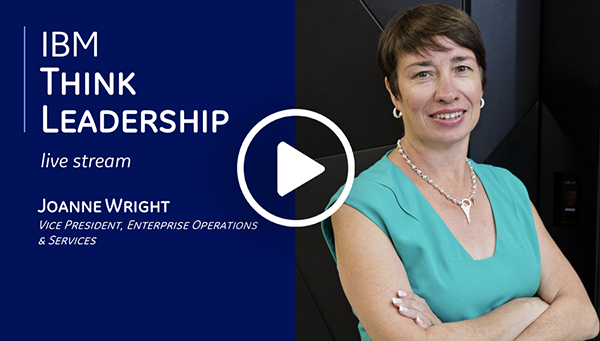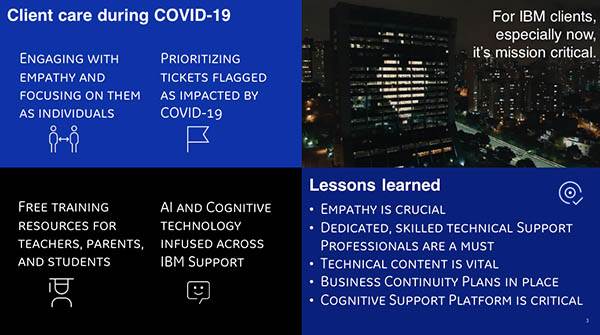IBM and Coronavirus stories
IBM VP Joanne Wright: Planning for Continuity in a Crisis

Watch a replay of Joanne Wright's livestream
In periods of tremendous turmoil, the predictability and assurance of everyday business operations are the foundation on which a return to normalcy can be built.
Business functions have been disrupted and made uncertain by the coronavirus. For operations managers maintaining organizational processes, both client and employee care take on new complexities when remote working is a new reality and travel restrictions remove the opportunity for face-to-face interactions.
“This has been a wake-up moment,” said Joanne Wright, IBM Vice President for Enterprise Operations & Services, on an IBM Think Leadership livestream conversation broadcast on April 21. “It’s a chance for all of us to be innovative together. Some things will get thrown out the window and, in other areas, we learned that some complexity doesn’t need to be so complex.”
For Wright, that means continually optimizing the efforts of the more than 8,000 support professionals that IBM has working around the globe with clients, as well as keeping her internal teams safe, connected and informed.
Wright is also one of the IBM leaders helping the company’s own massive digital transformation, shifting mission-critical business workloads to a hybrid cloud so IBM can become more agile and responsive to changing market and client demands. The scramble following the onset of COVID-19 accelerated that effort, as she explained in response to questions she received from clients and during the livestream.
How can companies provide high levels of customer support when businesses and employees are grappling with such massive change to the ways they conduct day-to-day operations?
For IBM, this is going to accelerate some customer care transformations that were already in progress. For one thing, it will be more virtual and collaborative. Suddenly, we can bring together incredible technical talent in front of a client, almost instantaneously. We have all grown up in a world where face-to-face selling and deal closure were so important. But virtual meetings as well as sales will soon become a normal way of life.
To be honest, I would have never thought that there would be a moment where we would run the whole IBM company from our own homes. But here we are, and we can learn from it. Meeting someone for the first time on Webex, for instance, may have felt weird at first, but I don’t think it is any longer. In a few weeks, we realized that it’s a great way to work together. The world is changing, and this will just be the way that life will be.
How much of this COVID change do you believe will continue in the post-pandemic future?
It’s an incredible and accelerated learning opportunity. The crisis of the past few weeks has shown how important it is to think creatively about how we bring a cross-functional support team with multi-dimensions of expertise together. That’s going to remain.
The unsettled quality has also given us a chance to bring AI into every aspect of our client support operations: understanding how they prioritize their workloads, what important areas they focus on, where they need to allocate their resources.
As a company, we’re very focused on agile metrics, and part of that is doing retrospectives. We, as a team at IBM, try to come together regularly to talk and share our experiences. Many of us were thinking we would do a retrospective at the end of this, but so much is changing that they are becoming more frequent.
So I ask my team what’s working and what isn’t on almost a weekly basis, and we focus on what they need to be productive and successful.
What have you learned from your customers?
That we share the same challenges, and hence the same opportunities and abilities to learn and grow. For instance, we use a geography- and market-based approach. That helped when we saw what was happening to some of our clients in China or South Korea, who were hit and impacted by the virus much earlier. We learned about what we did well and what we could do better.
Now we’re continuing to use those capabilities—our various tools and our agile collaboration approach—to share real-time experiences to support each other and our clients. A lot of this is simply about being able to listen and learn. Remember that being innovative does not mean that you have to go in and break something. You just have to move at a different rate and pace. That is what’s essential right now.

Are there any particular insights from the past few weeks that have been most valuable?
I think it comes down to one word: empathy. Every morning we come in and know that we have a lot of clients who depend on us to respond with speed and certainty to whatever issue they have. So we begin the day with a simple question: what does the client need of us right now?
We’re bringing the best technical resources. But we also need to come in with the right social skills to deeply understand the environments that many clients now find themselves in. We need to think about what they need to face the day ahead.
Also, we’ve all been able to look at each other in a new and different way. We’re all working at home, with this new mix of our business and personal lives. I’m at home with my 13-year-old twins, a Labrador retriever and two puppies. We see people working from their kitchens and dining rooms.
So I think we have a better understanding of each other, of our environments, and that will draw benefits in how we support each other. We’re all getting to know each other even more than before. I think this is something that will never change. It's going to be with us. It's going to be an integral part of who we are.
→ Visit the IBM News Room's complete coverage of IBM's response to the coronavirus pandemic
→ See the full lineup of the IBM Think Leadership Livestream series.